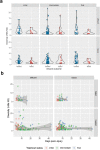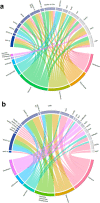Metagenomic features of bioburden serve as outcome indicators in combat extremity wounds
- PMID: 35970993
- PMCID: PMC9378645
- DOI: 10.1038/s41598-022-16170-x
Metagenomic features of bioburden serve as outcome indicators in combat extremity wounds
Abstract
Battlefield injury management requires specialized care, and wound infection is a frequent complication. Challenges related to characterizing relevant pathogens further complicates treatment. Applying metagenomics to wounds offers a comprehensive path toward assessing microbial genomic fingerprints and could indicate prognostic variables for future decision support tools. Wound specimens from combat-injured U.S. service members, obtained during surgical debridements before delayed wound closure, were subjected to whole metagenome analysis and targeted enrichment of antimicrobial resistance genes. Results did not indicate a singular, common microbial metagenomic profile for wound failure, instead reflecting a complex microenvironment with varying bioburden diversity across outcomes. Genus-level Pseudomonas detection was associated with wound failure at all surgeries. A logistic regression model was fit to the presence and absence of antimicrobial resistance classes to assess associations with nosocomial pathogens. A. baumannii detection was associated with detection of genomic signatures for resistance to trimethoprim, aminoglycosides, bacitracin, and polymyxin. Machine learning classifiers were applied to identify wound and microbial variables associated with outcome. Feature importance rankings averaged across models indicated the variables with the largest effects on predicting wound outcome, including an increase in P. putida sequence reads. These results describe the microbial genomic determinants in combat wound bioburden and demonstrate metagenomic investigation as a comprehensive tool for providing information toward aiding treatment of combat-related injuries.
© 2022. The Author(s).
Conflict of interest statement
The authors declare no competing interests.
Figures





Similar articles
-
Targeted metagenomic assessment reflects critical colonization in battlefield injuries.Microbiol Spectr. 2023 Dec 12;11(6):e0252023. doi: 10.1128/spectrum.02520-23. Epub 2023 Oct 24. Microbiol Spectr. 2023. PMID: 37874143 Free PMC article.
-
Microbial profiling of combat wound infection through detection microarray and next-generation sequencing.J Clin Microbiol. 2014 Jul;52(7):2583-94. doi: 10.1128/JCM.00556-14. Epub 2014 May 14. J Clin Microbiol. 2014. PMID: 24829242 Free PMC article.
-
Multidrug-Resistant and Virulent Organisms Trauma Infections: Trauma Infectious Disease Outcomes Study Initiative.Mil Med. 2022 May 4;187(Suppl 2):42-51. doi: 10.1093/milmed/usab131. Mil Med. 2022. PMID: 35512375 Free PMC article. Review.
-
Bacterial flora of combat wounds from eastern Ukraine and time-specified changes of bacterial recovery during treatment in Ukrainian military hospital.BMC Res Notes. 2017 Apr 7;10(1):152. doi: 10.1186/s13104-017-2481-4. BMC Res Notes. 2017. PMID: 28388920 Free PMC article.
-
IDCRP Combat-Related Extremity Wound Infection Research.Mil Med. 2022 May 4;187(Suppl 2):25-33. doi: 10.1093/milmed/usab065. Mil Med. 2022. PMID: 35512376 Free PMC article. Review.
Cited by
-
The influence of microbial colonization on inflammatory versus pro-healing trajectories in combat extremity wounds.Sci Rep. 2024 Mar 4;14(1):5006. doi: 10.1038/s41598-024-52479-5. Sci Rep. 2024. PMID: 38438404 Free PMC article.
-
Addressing the dynamic nature of reference data: a new nucleotide database for robust metagenomic classification.mSystems. 2025 Apr 22;10(4):e0123924. doi: 10.1128/msystems.01239-24. Epub 2025 Mar 20. mSystems. 2025. PMID: 40111052 Free PMC article.
-
Direct metagenomics investigation of non-surgical hard-to-heal wounds: a review.Ann Clin Microbiol Antimicrob. 2024 May 3;23(1):39. doi: 10.1186/s12941-024-00698-z. Ann Clin Microbiol Antimicrob. 2024. PMID: 38702796 Free PMC article. Review.

